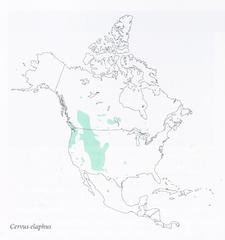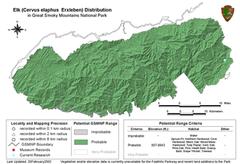|
|
Overview |
Throughout their range, elk inhabit a variety of habitats. They usually frequent high, open mountain pastures in
summer and move to lower wooded slopes, often dense woods, in winter.
- Special Protection Status
- Rangewide:
Elk are classified as a game species in most states where they occur and are protected by state game laws.
- In Park:
All plants and animals are protected within Great Smoky Mountains National Park.
Collection requires a permit which is usually granted only for
research or educational purposes.
|
|
|
Identification |
- Adult total length: 6 3/4 - 9 3/4 ft. (203 - 300 cm)
- Tail: 3 1/8 - 8 3/8 in. (80 - 213 mm)
- Height at shoulder: 4 1/2 - 5 ft. (137 - 150 cm)
- Weight: 450 - 1,089 lbs. (203 - 495 kg)
-
Physical Characteristics:
The elk is the second largest cervid in the world, second only to the moose.
The sides and back are grayish-brown, and the underparts are blackish.
The head, neck, and legs are dark brown. The rump and tail are buff-white.
A dark brown mane is present on the neck. Females possess four mammae.
The antlers usually possess at least five tines, with the brow tine forming an obtuse
angle with the beam (Linzey, 1998). Antlers can weigh over 28 pounds (13 kg.)
(Whitaker and Hamilton, 1998).
|
|
|
Names | |
|
|
|
Phylogeny | |
|
|
|
Geographic distribution |
Elk originally ranged over much of the United States.
Now, however, their range has been restricted mainly to scattered localities in the western half of the United States.
The largest contiguous range exists in the Rocky Mountains south to northern New Mexico.
Small, isolated, introduced populations exist in Pennsylvania, Michigan, Kentucky, and several other states.
-
Range Maps
| North America |
Great Smokies |

|

|
-
Great Smoky Mountains National Park:
Linzey and Linzey (1968) summarized the history of this species in the park and surrounding area:
"Although the American elk roamed throughout the mountains in former times, it has become extirpated.
In 1896, Rhoads stated: "At the beginning of the present century, this noble animal was probably a
visitant to every county in the state [Tennessee]." Ganier (1928) reported that
the last one in eastern Tennessee was shot in 1849.
In discussing the status of this mammal in North Carolina, Hamnett and Thornton (1953)
reported that it "once inhabited at least a portion of North Carolina including the northern Piedmont and Mountain
counties. It is doubtful if they were ever very numerous, however, since this region was near the southern limits
of their range." They stated further that "...it probably was present in the Mountain Region until the late
1700's." Brimley (1945) recorded that elk occurred in colonial times in the mountains
of North Carolina until at least 1750. Cope (1870) noted that horns of elk were found in
the Black Mountains in western North Carolina in the early 1800's."
In February 2001, 12 cows ( 6-9 of which were pregnant) and 13 bulls from Kentucky's Land Between the Lakes
were released in Cataloochee Valley. At least four of the cows gave birth. Twenty-five additional elk are
expected to be released in the park during 2002, and 25 more the following year.
|
|
|
Natural history |
- Reproduction
The rutting season extends from August to November, peaking in October and November. During this time,
adult bulls assemble harems of up to 60 cows. Bulls give their bugling call, roll in wallows
of stagnant water and mud, and urinate on vegetation. After a gestation of about 255-275
days, a cow leaves the herd to give birth usually to 1 calf, sometimes 2, weighing
25 to 40 pounds. After a week, the cow rejoins the herd with her calf. The calf is
entirely dependent on milk for one month. Weaning is completed in two months. Protective
adaptations of young elk include a spotted pelage, a lack of scent, and a capacity to remain still and silent.
The first elk calf born in the park was born on June 22, 2001. The birth of
4 calves were confirmed during 2001. One calf may have been stillborn and one was most likely killed by a coyote.
- Longevity
Elk have been known to live for at least 25 years in captivity, but seldom reach this age in
the wild (Whitaker and Hamilton, 1998).
- Terrestrial Ecology
Elk are primarily nocturnal but are most active at dawn and dusk. Larger herds occur in open areas
with smaller groups being found in wooded areas. Territories are marked by rubbing the sides of the chin
and muzzle on freshly stripped seedlings.
Rutting bulls emit a "bugle" or "whistle" which serves as a warning to other bulls
and a means of domination to cows. The vocalization begins as a bellow, changes almost immediately to
a loud, shrill whistle or scream, and ends with a series of grunts. Cows neigh to
their calves and may also whistle during the spring but not as loudly as bulls.
Elk are primarily grazers in spring and summer, but may become browsers feeding on woody vegetation in winter
if grasses, sedges, and forbes are unavailable. Lichens are also consumed.
- Predators and Defense
Major predators include mountain lions, bears, and coyotes. One of the first calves born in the
park in 2001 is thought to have been killed by a coyote.
- Parasites
On September 23, 2001, an adult female elk in the park was euthanized after showing neurological and
physical signs consistent with meningial worm (Parelaphostrongylus tenuis).
Meningial worm is usually carried passively in white-tailed deer. However,
in nearly all other Cervidae, including elk, the meningial worm produces neurological problems
that often result in death.
|
|
|
Links to other sites | |
|
|
|
References |
-
Brimley, C. S. 1944-46.
The Mammals of North Carolina. Eighteen installments in Carolina Tips. Carolina Biological Supply Company,
Elon College, North Carolina.
-
Cope, E. D. 1870.
Observations on the fauna of the southern Alleghenies. American Naturalist 4 (7): 392-402.
-
Ganier, A. F. 1928.
The wild life of Tennessee. Journal of the Tennessee Academy of Science 3 (3): 10-22.
-
Hamnett, W. L. and D. C. Thornton. 1953.
Tar Heel Wildlife. North Carolina Wildlife Resources Commission, Raleigh, North Carolina.
-
Linzey, D. W. 1998.
The Mammals of Virginia. Blacksburg, Virginia: The McDonald & Woodward Publishing Company, Inc.
-
Linzey, D. W. and A. V. Linzey. 1968.
Mammals of the Great Smoky Mountains National Park. Journal of the Elisha Mitchell Scientific Society 84 (3): 384-414.
-
Peek, J. M. 1982.
Elk. Pages 851-861. In: Chapman, J. A. and C. A. Feldhamer (editors).
Wild Mammals of North America. Baltimore: Johns Hopkins University Press.
-
Rhoads, S. N. 1896.
Contributions to the zoology of Tennessee. Number 3: Mammals. Proceedings of the Philadelphia Academy of
Natural Sciences 48: 175-205.
-
Whitaker, J. O., Jr. and W. J. Hamilton, Jr. 1998.
Mammals of the Eastern United States. Ithaca, New York: Comstock Publishing Associates.
|
|
|
Acknowledgements |
- Text
- Photographs
- Map development
- Web page design & coding
- Casandra Lloyd, University of Georgia, Athens
- John Pickering, University of Georgia, Athens
|
|
| Supported by | |
|
Following modified from Australian Faunal Directory
|
Top | See original
| &pull 20q v5.145 20180528: Error 301 Moved Permanently http://biodiversity.org.au/afd/taxa/70943adf-8589-40e9-8338-7ba862074b86 |
|
Following served from Roger W. Barbour |
Top | See original context
|
Following modified from North American Mammals, Smithsonian Institution
|
Top | See original
| &pull 20q v5.145 20180528: Error 301 Moved Permanently http://www.mnh.si.edu/mna/image_info.cfm?species_id=33 |
Updated: 2024-05-07 04:51:25 gmt
|
